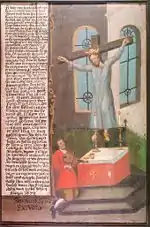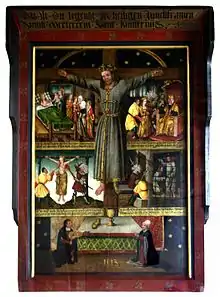Wilgefortis
Wilgefortis is a female saint of the Catholic Church whose legend arose in the 14th century,[1] and whose distinguishing feature is a large beard. Her name is thought to have derived from the Latin "virgo fortis" ("courageous virgin").[2] In England her name was Uncumber, and in Dutch Ontkommer (meaning one who avoids something, here specifically other people from suffering). In German lands she was known as Kümmernis ("grief" or "anxiety"). In Poland she was called Frasobliwa ("sorrowful"). She was known as Liberata in Italy and Librada in Spain ("liberated"), and as Débarras ("riddance") in France. In places such as Sigüenza, Spain, she was sometimes conflated with another Saint Liberata, the sister of Saint Marina of Aguas Santas, whose feast was also celebrated on July 20.[3] She was venerated by people seeking relief from tribulations, in particular by women who wished to be liberated ("disencumbered") from abusive husbands.
Saint Wilgefortis | |
|---|---|
 | |
| Venerated in | Catholicism |
| Feast | in some places formerly July 20 |
| Attributes | Bearded woman; depicted crucified, often shown with a small fiddler at her feet, and with one shoe off |
| Patronage | Relief from tribulations, in particular by women who wished to be liberated ("disencumbered") from abusive husbands; facial hair |
History

Art historians have argued that the origins of the art can be found with Eastern-style representations of the crucified Christ, and in particular the Holy Face of Lucca, a large 11th-century carved wooden figure of Christ on the Cross (now replaced by a 13th-century copy), bearded like a man, but dressed in a full-length tunic that might have appeared to be like that of a woman instead of the loin cloth familiar and by the Late Middle Ages normal in depictions in the West.[lower-roman 1]
The theory is that when the composition was copied and brought north of the Alps over the next 150 years, in small copies by pilgrims and dealers, this unfamiliar image led Northerners to create a narrative to explain the androgynous icon.[6] Some older images of the crucified Christ were repurposed as Wilgefortis, and new images clearly intended to represent the saint created, many with female clothes and breasts. Some older images of Christ on the cross are argued to have already deliberately included hints at an androgynous figure for theological reasons.[7] Single images normally showed Wilgefortis on her cross, but two prominent standing images where she carries a smaller cross as an attribute as part of a group of saints, are mentioned below. Images showing a set of scenes covering the whole legend are unusual, but a German one of 1513 is illustrated here.
Veneration

The popularity of prayer in the period of the Middle Ages has been connected to the Devotio Moderna and related devotion, where meditation on and identification with the sufferings of Christ was encouraged by writers such as Thomas à Kempis author of The Imitation of Christ or mostly encouraged by the Groote to focus on the personal structure of simplicity, obedience, and followed the book The Imitation of Christ circulating from the 1420s.[8]
According to the narrative of the life of this Saint, set in Portugal and Galicia, a teen-aged noblewoman named Wilgefortis had been promised in marriage by her father to a Muslim king. To thwart the unwanted wedding, she had taken a vow of virginity, and prayed that she would be made repulsive. In answer to her prayers she sprouted a beard, which ended the engagement. In anger, Wilgefortis's father had her crucified.
St Wilgefortis remained popular in the North until the end of the Gothic period; there is an especially attractive carving in the Henry VII Chapel of Westminster Abbey of a beautiful standing Wilgefortis holding a cross, with a very long beard.[9] She also appears in a similar pose, very lightly bearded, on the outside of a triptych door by Hans Memling.[9] She was decisively debunked during the late 16th century (after a period in the 15th and 16th centuries in which she was popular), and thereafter disappears from high art, although lingering well into the 20th century in more popular forms, especially in Bavaria and Austria,[10] but also in northern France and Belgium. In the 12th-century church of Saint-Etienne in Beauvais, there is a 16th-century wooden statue of Saint Wilgefortis on the cross. She is depicted in a full blue tunic and sports a substantial beard. She is venerated by the name of Santa Librada, in Argentina and Panama.[11]
She is often shown with a small fiddler at her feet, and with one shoe off. This derives from a legend, also attached to the Volto Santo of Lucca, of a silver shoe with which the statue had been clothed dropping spontaneously at the feet of a poor pilgrim. In the Wilgefortis version the poor devotee became a fiddler, perhaps in the 13th century.[12]
In Popular Culture
A fascination with Wilgefortis grips the narrator of Fifth Business, the 40th-best novel of the 20th century according to the Modern Library's readers' list.[13]
See also
References
- The Holy Face is sometimes described as typical of early Byzantine robed crucifixes.[4] But no comparable large carved figures formed part of Byzantine art, whilst there are several surviving from Germany. Any Byzantine influence is very remote, as the face and hair are typical of German crucifixes, and many Ottonian manuscripts show robes in crucifixions. The Byzantine examples are from icons, illuminations or small relief carvings.[5]
- Friesen (2001), p. 15.
- More, Alison (2018). Fictive orders and feminine religious identities, 1200–1600. Oxford University Press. p. 130. ISBN 0198807694.
- Friesen (2001), pp. 47–48.
- John Shinners (2003). "Religion, Popular: Cult of Saints", in Dictionary of the Middle Ages, Supplement 1. ISBN 0-684-80642-8
- G Schiller, Iconography of Christian Art, Vol. II,1972 (English trans from German), Lund Humphries, London, figs 327–37, 379–394, 455–75, ISBN 0-85331-324-5
- James Hall, A History of Ideas and Images in Italian Art, p. 172, 1983, John Murray, London, ISBN 0-7195-3971-4
- Friesen (2001), pp. 27–29.
- Friesen (2001), pp. 21–32.
- http://www.philipresheph.com/a424/study/picview.html URL unavailable 17 March 2018.
- Friesen (2001).
- Marcella Althuas-Reid. Indecent Theology: Theological Perversions in Sex, Gender, and Politics. (London. Routledge: 2000), pp.83–87
- Friesen (2001), Chap. 3.
- "Readers' List: 100 Best Novels", Random House Modern Library
Bibliography
| Wikimedia Commons has media related to Saint Wilgefortis. |
- Friesen, Ilse E. (2001). The Female Crucifix: Images of St. Wilgefortis Since the Middle Ages. Wilfrid Laurier University Press. ISBN 0-88920-365-2.CS1 maint: ref=harv (link)
- Wilgefortis from the Catholic Encyclopedia.
- Robertson Davies (1970). Fifth Business, ISBN 978-0-14-026049-6